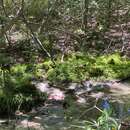Comments
provided by eFloras
Nuttall did not designate a type specimen for Carex collinsii; he clearly did not intend that name to provide a legitimate name for the later homonym C. subulata Michaux, but listed both of the names. As K. K. Mackenzie (1931–1935, parts 2–3, pp. 704–705) pointed out, the locality of the type specimen for C. subulata Michaux is apparently erroneous because that species does not occur in Canada. The specimen in the Michaux herbarium (P, photo!) is C. collinsii.
- license
- cc-by-nc-sa-3.0
- copyright
- Missouri Botanical Garden, 4344 Shaw Boulevard, St. Louis, MO, 63110 USA
Description
provided by eFloras
Culms trigonous with obtuse angles, 15–75 cm, to 3 mm diam. at base, glabrous. Leaves: sheaths to 2.5 cm; blades 30–35 cm × 5 mm. Inflorescences 10–30 cm; peduncles of proximal spikes to 4 cm; bracts 8–15 cm × 3–5 mm, shorter than inflorescences; lateral spikes 4–5, 6–10-flowered, 1 × 2.5 cm. Scales white or translucent with green midvein, ovate, body to 2.5 mm, less than 0.5 length of perigynia, herbaceous, apex acute, acuminate or mucronate, awn to 0.5 mm. Perigynia green with red-brown spots, 15–20 raised veins, to 15 × 1.2 mm; beak obliquely cut, herbaceous, teeth cartilaginous, to 1 mm; style curved, short stigmas protruding from perigynium at base of oblique orifice. Achenes yellow-brown, oblong, obtusely angled, 3 × 1 mm, tightly enclosed by perigynia, dull.
- license
- cc-by-nc-sa-3.0
- copyright
- Missouri Botanical Garden, 4344 Shaw Boulevard, St. Louis, MO, 63110 USA
Distribution
provided by eFloras
Conn., Del., Ga., Md., N.J., N.Y., N.C., Pa., R.I., S.C., Va.
- license
- cc-by-nc-sa-3.0
- copyright
- Missouri Botanical Garden, 4344 Shaw Boulevard, St. Louis, MO, 63110 USA
Habitat
provided by eFloras
Shaded sphagnum bogs or seeps, characteristically under Chamaecyparis thyoides or Picea mariana; 0–700m.
- license
- cc-by-nc-sa-3.0
- copyright
- Missouri Botanical Garden, 4344 Shaw Boulevard, St. Louis, MO, 63110 USA
Synonym
provided by eFloras
Carex michauxii Dewey 1826, not Schweinitz 1824; C. subulata Michaux 1803, not J. F. Gmelin 1791
- license
- cc-by-nc-sa-3.0
- copyright
- Missouri Botanical Garden, 4344 Shaw Boulevard, St. Louis, MO, 63110 USA
Comprehensive Description
provided by North American Flora
Carex collinsii Nutt. Gen. 2: 205. 1818
Carex subulata Michx. Fl. Bor. Am. 2: 173. 1803. (Type given as from "Canadae borealibus".) Not C. subulata J. F. Gmel. 1791 ; nor Schum. 1801 ; nor Wahl. 1803.
Carex Michauxii Dewey, Am. Journ. Sci. 10: 273. pi. G,f. 21. 1826. (Based on C. subulata Michx.) Not C. Michauxii Schw. 1824.
Olotrema Collinsii Raf. Good Book 25. 1840. (Based on Carex Collinsii Nutt.)
Very densely cespitose, the rootstocks very short, not stoloniferous, the clumps large, the culms 1.5-6 dm. high, slender and usually weak, exceeding the leaves but not the bracts, phyllopodic, obtusely triangular, smooth, purplish-tinged at base; leaves (not bracts) with well-developed blades usually 3-5 to a fertile culm, chiefly toward the base, inconspicuously septate-nodulose, the blades thin, soft, green, flat, usually 5-15 cm. long, 2-4 mm. wide, roughened toward the apex, the sheaths tight, concave at mouth, the ligule as long as wide; staminate spike solitary, occasionally with a few perigynia at base, sessile to strongly peduncled, few-flowered, linear, 5-10 mm. long, 1-2 mm. wide, the scales ovate-lanceolate, acute to cuspidate, white-hyaline with conspicuous green center; pistillate spikes 2-4, erect, widely separate, usually sparingly staminate above, shortto long-exsert-peduncled, much wider than long, the peduncles slender, roughish, the perigynia 1-8, spreading at right angles or reflexed; bracts leaf -like, strongly sheathing, the sheaths short-prolonged at mouth; scales ovate-lanceolate or lanceolate, long-persistent, awned or cuspidate, hyaline with green midrib, narrower than and about one third as long as the perigynia; perigynia subulate, 8-12 mm. long, 1-2 mm. wide, suborbicular in cross-section, little inflated, membranaceous, smooth, deepgreen, reddish-brown-dotted, easily detaching from rachis, many-nerved, round-tapering at base and short-stipitate, tapering into the smooth, very strongly obliquely fissured, deeply bidentate beak half the length of the body, the teeth very slender, awn-like, 1.5-2 mm. long, becoming very strongly reflexed back against the beak; achenes linear-oblong, 2.5-3 mm. long, 0.75 mm. wide, triangular with convex sides and prominent angles, in lower half of perigynium-body, yellowish-brown, substipitate, abruptly apiculate and continuous with the long, slender, straight or flexuous style; stigmas 3, reddish-brown, slender, short.
Type locality: "Hab. In the most shady sphagnose swamps; New Jersey."
Distribution: In dense shade in very wet white cedar or black spruce swamps, Rhode Island to eastern Pennsylvania and southward to South Carolina and Georgia; mostly on the coastal plain, but also known from a few stations in the mountains of Pennsylvania and northwestern New Jersey. (Specimens examined from Rhode Island, Connecticut, New York, New Jersey, Pennsylvania, Delaware, Maryland, North Carolina, South Carolina, Georgia.)
- bibliographic citation
- Kenneth Kent Mackenzie. 1935. (POALES); CYPERACEAE; CARICEAE. North American flora. vol 18(7). New York Botanical Garden, New York, NY
Carex collinsii: Brief Summary
provided by wikipedia EN
Carex collinsii, common name Collins' sedge, is a species of Carex native to North America. It is listed as a special concern species and believed extirpated in Connecticut. It is listed as endangered in New York, as threatened in Pennsylvania, and its historical range included Rhode Island.
- license
- cc-by-sa-3.0
- copyright
- Wikipedia authors and editors

